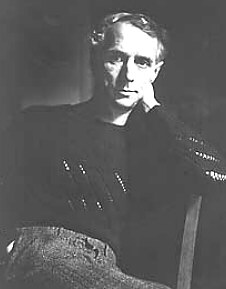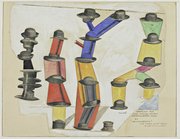Max Ernst
|
|
Max Ernst (April 2, 1891 – April 1, 1976) was a German painter.
Max Ernst was born in Brühl, Germany. In 1909, he enrolled in the University at Bonn to study philosophy but soon abandoned these courses to pursue his interest in art. In 1913 he met Guillaume Apollinaire and Robert Delaunay and traveled to the Montparnasse Quarter in Paris where a gathering of artists from around the globe was taking place.
In 1918, he married the art historian Luise Straus, a stormy relationship that would not last. The next year he visited Paul Klee and created his first paintings, block prints and collages, and experimented with mixed media. During World War I he served in the German army and after the war, filled with new ideas, Max Ernst, Jean Arp and social activist Alfred Grünwald, formed the Cologne, Germany Dada group but two years later in 1922, he returned to the artistic community at Montparnasse in Paris.
Constantly experimenting, in 1925 he invented frottage, a technique using pencil rubbings of objects. The next year he collaborated with Joan Miró on designs for Sergei Diaghilev. With Miró's help, Max Ernst pioneered grattage in which he troweled pigment from his canvases. Max Ernst helped to found the Dada movement, drawing a great deal of controversy with his 1926 painting The Virgin Spanking the Christ Child before Three Witnesses: Andre Breton, Paul Eluard, and the Painter. In Montparnasse, he was important in the birth of Surrealism where an artist used images in a way that made no logical sense, instead making the whims of their psyche the source of their subject matter. After a period with the Surrealists, Ernst left their group due in part to Andre Breton's desire to ostracize Ernst's friend, the poet Paul Eluard. In 1934 he began to work in sculpture, spending time with Alberto Giacometti. In 1938, the American heiress Peggy Guggenheim acquired a number of Max Ernst's works which she displayed in her new museum in London.
Throughout this period, Ernst developed a fascination with birds that was prevelent in his work. His alter ego in paintings, that he called Loplop, was a fictional bird that he suggested was an extension of himself stemming from an early confusion of birds and humans. Ernst claimed his sister was born soon after his bird died, but this could have been a story he invented to promote the "art" of his art. Loplop often appeared in collages of other artists work, such as collages like Loplop presents Andre Breton and they usually had a bird foot-like object superimposed on another artists piece. Birds continued to appear in Ernst's work, in such instances like the Angel of Hearth and Home and Robing of the Bride, two of his post World War II paintings.
Following the outbreak of World War II, Max Ernst was detained as an enemy alien but with the assistance of the American journalist Varian Fry in Marseille, he managed to escape the country with Peggy Guggenheim. They arrived in the United States in 1941 and were married the following year. Living in New York City, along with Marcel Duchamp and Marc Chagall, fellow avant-garde painters who had fled the War in Europe, Max Ernst helped inspire the use of Abstract expressionism among American painters.
Murdering_Airplane.jpg
His marriage to Peggy Guggenheim did not last, and in Beverly Hills, California in October of 1946, in a double ceremony with Man Ray and Juliet Bowser he married Dorothea Tanning. Ernst remained primarily in the United States, living in Sedona, Arizona and in 1948 wrote the treatise "Beyond Painting" before visiting Europe in 1950. He returned to Paris permanently in 1953 and the following year he won the Venice Biennale. As a result of the publicity, he began to achieve financial success.
In 1963 he and his wife moved to a small town in the south of France where he continued to work. He designed stage sets and a fountain for the city of Ambois. In 1975, a retrospective of his works was held at the Solomon R. Guggenheim Museum in New York City, and the Galeries Nationales du Grand-Palais in Paris published a complete catalogue of his works.
Max Ernst died on April 1, 1976, in Paris, France and was interred there in the Père Lachaise Cemetery.
American post punk group Mission of Burma titled two songs after the artist: 1979's "Max Ernst", and 2004's "Max Ernst's Dream".
Selected list of works
The_Elephant_Celebes.jpg
Oedipus_Rex.jpg
ConstructedbyMinimaxDadamax.jpg
- 1919 Trophy, Hypertrophied
- 1919 Farewell My Beautiful Land of Marie Laurencin. Help! Help!
- 1919 Aquis Submersus
- 1919-20 Little Machine Constructed by Minimax Dadamax in Person
- 1920 The Hat Makes the Man
- 1920 Here Everything is Still Floating
- 1920 Dada Gauguin
- 1921 The Elephant Celebes
- 1921 Birds, Fish-Snake and Scarecrow
- 1921 Seascape
- 1921 Approaching Puberty or the Pleiads
- 1922 Oedipus Rex
- 1923 Holy Caecilie - The Invisible Piano
- 1923 Men Shall Know Nothing of This
- 1923 Histoire Naturelle
- 1923 The Equivocal Woman
- 1923 Pieta or Revolution by Night
- 1923 Ubu Imperator
- 1923-4 Woman, Old Man and Flower
- 1924 Two Children are Threatened by a Nightingle
- 1924 Dadaville
- 1925 Mer et Soleil - Lignes de Navigation
- 1925 Paris Dream
- 1926 The Numerous Family
- 1927 The Kiss
- 1927 Der grosse Wald
- 1927 Gulf Stream
- 1927 Forêt
- 1927 Forest and Dove
- 1927 Fishbone Forest
- 1928 Tree of Life
- 1928 The Sea
- 1928 Die Erwählte des Bösen
- 1929 Et les Papillions se Mettent a Chanter
- 1933 Zoonomorphic Couple
- 1934 The Entire City
- 1936 The Nymph Echo
- 1937 L’Ange du Foyer ou Le Triomphe du Surréalime
- 1940 Attirement of the Bride
- 1940 Spanish Physician
- 1940-2 Europe After the Rain
- 1941-2 Day and Night
- 1942 Surrealism and Painting
- 1943 Window
- 1943-4 The Eye of Silence
- 1944 The King Playing with the Queen
- 1944 Moonmad
- 1944 The Table is Set
- 1944 Napoleon in the Wilderness
- 1946 Phases of the Night
- 1947 Dangerous Correspondance
- 1948 Capricorn
- 1950 Parisian Woman
- 1951 The Weatherman
- 1956 L’oiseau Rose
- 1956 Der Rosa Vogel
- 1958 Petite Feerie Nocturne
- 1960 Paysage Arizona
- 1960 Ursachen der Sonne
- 1965 Grand Ignorant
- 1967 Corps Enseignant Pour une École de Tueurs
- 1968 Nordlicht am Nordrhein
- 1970 Ein Mond ist guter Dinge
External links
- Max Ernst Paintings (http://www.fantasyarts.net/Max_Ernst.htm), Biography, and Historical Information
- Max Ernst at Olga's Gallery (http://www.abcgallery.com/E/ernst/ernst.html)de:Max Ernst
es:Max Ernst fr:Max Ernst it:Max Ernst ja:マックス・エルンスト pt:Max Ernst sv:Max Ernst



